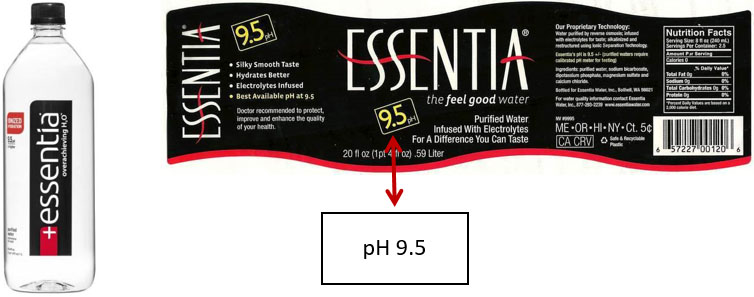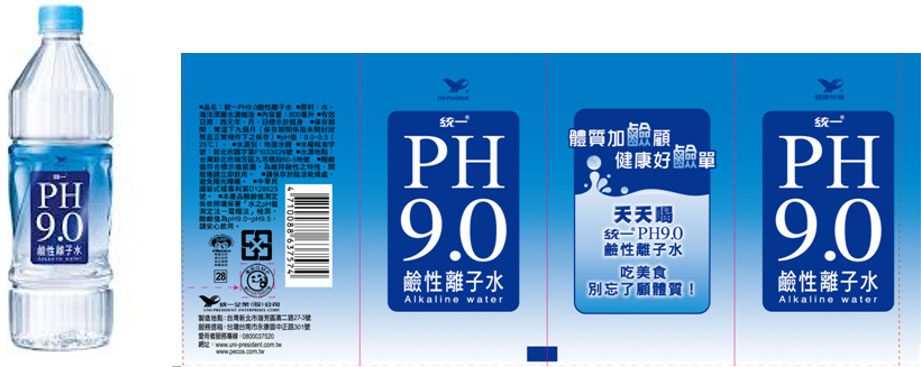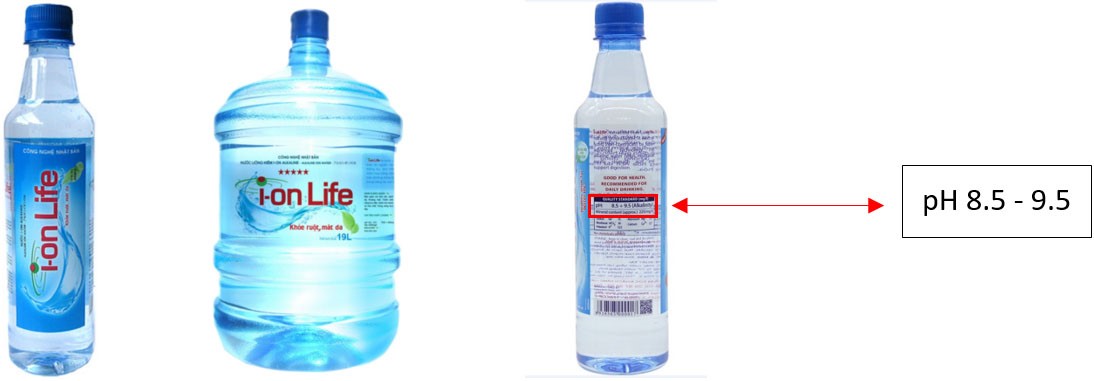 |
| LEADER OF ELECTROLYSIS TECHNOLOGY |
The pH of Bottled Water
The pH limitation has set for tap water (pH is 6.0-8.5) internationally and the reason is because of the corrosive problem that could possibly be found in the pipe water where the tap water travels, that could affect the public’s health. However, after the water is treated (through filtration or purification processes), this pH limitation is not applicable for tap water.
Bottled water requires the use of nationally qualified raw water. After filtration and sterilization, it is refilled and sold. Therefore, applying the limitation of pH value of 6.0-8.5 for tap water to bottled water is a misunderstanding.
Regarding the pH standard in bottled drinking water, we would like to provide some information as followed:
1. Food Law
According to the Food Law, bottled drinking water is regarded as food, so like other food products, bottled drinking water needs to be safe for consumption, no matter what the pH values are.
In the US, bottled water is also regulated by FDA as food. Under the FFDCA (Federal Food, Drug, and Cosmetic Act), manufacturers are responsible for producing safe, wholesome and truthfully labeled food products, including bottled water products. FDA has established specific Standard of Quality for bottled water in Title 21 of the Code of Federal Regulation (21 CFR). The guideline has no pH limitations.
The link to the full version of the 21CFR:
https://www.accessdata.fda.gov/scripts/cdrh/cfdocs/cfcfr/CFRSearch.cfm?fr=165.110
2. WHO
According to the published WHO Drinking Water Guideline on page 409 indicated that:
[No health-based value is proposed for pH. Reason for not establishing a guideline value Not of health concern at levels found in drinking-water].
The link below is for the full version of the guideline by WHO:
http://apps.who.int/iris/bitstream/handle/10665/44584/9789241548151_eng.pdf;jsessionid=8CDC0D07EF25B04CC9810495536CD1EF?sequence=1
Attachment (1). Page 409 WHO Drinking Water Guideline.
3. US - FDA
In addition, according to the official information from FDA government website, the FDA and EPA are both responsible for the safety of drinking water. EPA regulates public drinking water (tap water), while FDA regulated bottled drinking water.
The link below is the official FDA website:
https://www.fda.gov/Food/ResourcesForYou/Consumers/ucm046894.htm
Based on the 21CFR, FDA has no any pH limitations for bottled water although EPA recommended the pH value of 6.5-8.5 for tap water.
4. Japan’s Law and Regulation
Alkaline ionized water is regulated under bottled water standard and there are no pH value limitations. For details, please refer to the link of the website of Japan Law Translation.
The link below is the Japanese Law Translation website:
http://www.japaneselawtranslation.go.jp/
5. Taiwan’s Law and Regulation (for reference)
In Taiwan, The Sanitation Standard For Bottled and Packaged Drinking Water has NO item of pH value and has no pH value limitation for bottled water.
Further, The Drinking Water Quality Standards has the limitation of pH 6.0~8.5, however, the drinking water (such as tap water) has through filter treated then after has NO any pH limitation. Such as water dispensers or water equipment installed and serving the drinking water to public at stations or airports, schools...etc.has NO any pH limitation.
According to The Tap Water Law, the pH limitation for tap water ranges of 6.0-8.5 and the reason for such limitation is because of the corrosive problem could possibly be found from the water pipes where the tap water travels and could cause tap water became acidifying due to water pipes could be rusting or contaminated which the tap water could affect to public’s health.
However, after the tap water is treated through filtrations or purification processes, Then the pH limitation is no longer applicable for this tap water.
The link below is the full version of the Taiwan’s Law and Regulation for drinking water:
http://law.moj.gov.tw/ENG/LawClass/LawAll.aspx?PCode=O0040019
Attachment (2). Taiwan’s Law and Regulation regarding pH.
6. Alkaline Bottled Water products are being sold worldwide
As we knew, most of the countries around the world do not have pH limitation for bottled drinking water.
In fact, alkaline ionized water products are being sold worldwide from USA, Canada, Australia, New Zealand, EU countries, Japan, Taiwan, China and Vietnam...etc.
Some examples are currently selling of alkaline water products include (Please refer to attachment 3 for product labels and descriptions):
- Essentia from USA (pH 9.5)
- Kirin Alkali Ion Water from Japan (pH 9.5)
- Vietnam Ion Life (pH 9.5)
- Taiwan Uni-President pH 9.0
- Taiwan Salt (Taiyen) Alkaline Ion Water (pH 9.5)
Attachment (3). Pictures of Alkaline Water Products (pH 9.0-9.5) around the world.
7. Household Water Ionizers
Household water ionizers which produced electrolysis alkaline water with pH ranging from 8.0-9.8, have been sold throughout the world for more than 40 years.
The household water ionizers have been granted certification of medical devices by MOH Japan and South Korea. These household ionizers are also being sold in Dubai, UAE. The household water ionizers based on scientific and medical clinic experiments that alkaline water is effective to help improving abdominal problems.
Attachment (4). Certification from Japan MOH for Household Water Ionizers as Medical Devices (Japanese version).
Attachment (5). Certification from South Korea for Household Water Ionizers (Korean version).
ATTACHMENTS
Attachment (1). Page 409 WHO Drinking Water Guideline.
In the event of a spill, it may be necessary to carry out a context-specific assessment of the risk to health. The fact that petroleum products are complex mixtures of many individual hydrocarbons is a complicating factor in determining the potential risks to consumers. The traditional approach of evaluating individual chemicals in assessing the risks from drinking-water is therefore largely inappropriate. In order to overcome this difficulty, it is more practical to consider a series of hydrocarbon fractions and to determine appropriate tolerable concentrations for those fractions. The most widely accepted approach is that developed by the Total Petroleum Hydrocarbons Criteria Working Group in the USA, which divided total petroleum hydrocarbons into a series of aliphatic and aromatic fractions based on the number of carbon atoms and the boiling point, to give equivalent carbon numbers. This pragmatic approach provides a suitable basis for assessing the potential health risks associated with larger-scale contamination of drinking-water by petroleum products. The allocation of 10% of each of the reference doses, equivalent to TDIs, for the various fractions to drinking-water provides a conservative assessment of the risks. Although the approach is based on the analysis of hydrocarbon fractions, most are of low solubility, and the most soluble fractions, consisting largely of lower molecular weight aromatic hydrocarbons, will be present in the greatest concentration.
pH
No health-based guideline value is proposed for pH. Although pH usually has no direct impact on consumers, it is one of the most important operational water quality parameters (see chapter 10).
| Reason for not establishing a guideline value | Not of health concern at levels found in drinking-water |
| Additional comments | An important operational water quality parameter |
| Assessment date | 1993 |
| Principal reference | WHO (2007) pH in drinking water |
2-Phenylphenol and its sodium salt
2-Phenylphenol (CAS No. 90-43-7) is used as a disinfectant, bactericide and virucide. In agriculture, it is used in disinfecting fruits, vegetables and eggs. It is also used as a general surface disinfectant in hospitals, nursing homes, veterinary hospitals, poultry farms, dairy farms, commercial laundries, barbershops and food processing plants. 2-Phenylphenol is readily degraded in surface waters, with a half-life of about 1 week in river water.
Attachment (2). Taiwan’s Law and Regulation regarding pH.
Weblink:
http://law.moj.gov.tw/ENG/LawClass/LawAll.aspx?PCode=O0040019
D. Limit range of residual chlorine (Limited to water supply systems using chlorine as disinfectant):
| Item | Maximum limit | Unit |
|---|---|---|
| Free available residual chlorine | 0.2-1.0 | milligrams/liter |
E. Range for pH index (water treated by stationary continuous water supply equipment on public or private premises are not be subjected to this limitation):
| Item | Maximum limit | Unit |
|---|---|---|
| Hydrogen ion concentration index (pH value) |
6.0-8.5 | No unit |
Attachment (3). Pictures of Alkaline Water Products around the world.
Currently sold Alkaline Ionized Water in the market
a) Essentia Water from USA (pH 9.5)

Website: https://essentiawater.com/
b) Kirin Alkaline Ion Water from JAPAN (pH 8.5 - 9.3)

Website: https://www.kirin.co.jp/company/english/about/kirinbeverage/
c) Alkaline Ion Water from Uni-President TAIWAN (pH 9.0)

Website: https://www.uni-president.com/
d) Taiyen Ocean Alkaline Ion Water from TAIWAN (pH 8.0-9.5)

Website: http://www.tybio.com.tw/
e) Ion Life Water from VIETNAM (pH 8.5-9.5)

Website: http://www.ionlife.com.vn/
Attachment (4). Certification from Japan MOH for Household Water Ionizers as Medical Devices.

Attachment (5). Certification from South Korea for Household Water Ionizers.

 English
English  繁體中文
繁體中文  简体中文
简体中文 



